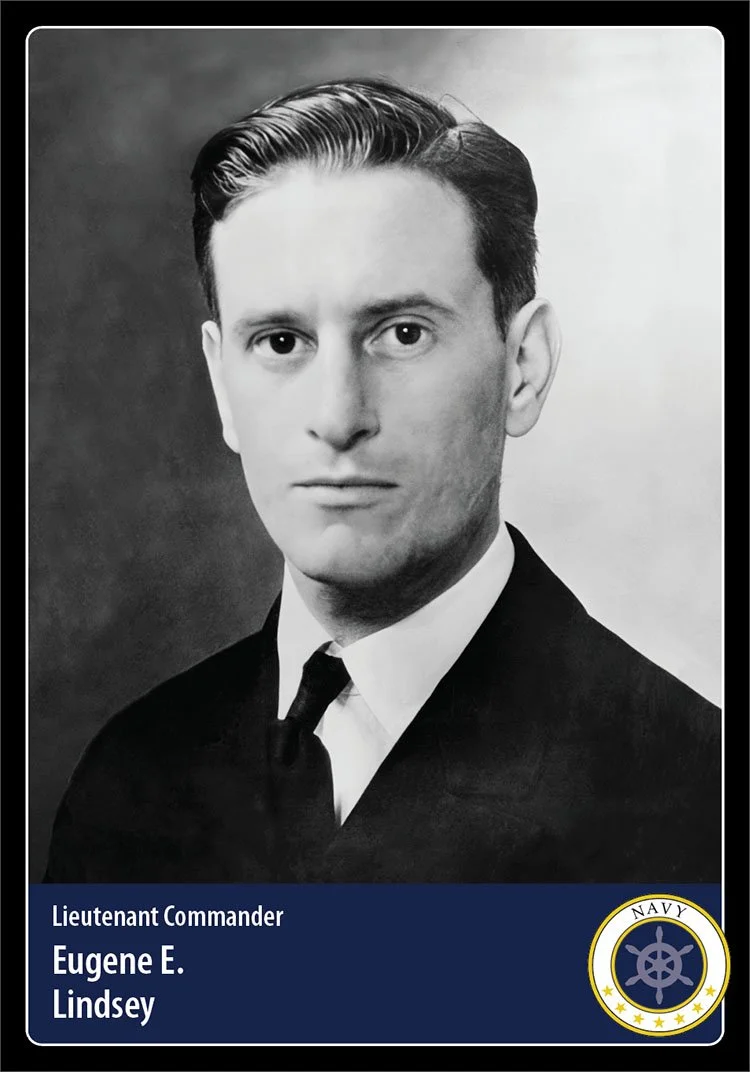Hero Card 199, Card Pack 17
Photo: Naval History and Heritage Command, NH 84903 (digitally restored), Public Domain
Hometown: Sprague, WA
Branch: U.S. Navy
Unit: Torpedo Squadron SIX (VT-6),
USS Enterprise (CV-6)
Military Honors: Navy Cross, Distinguished Flying Cross (2), Purple Heart
Date of Sacrifice: June 4, 1942 - KIA Near Midway Atoll
Age: 36
Conflict: World War II, 1939-1945
As a young man, Eugene “Gene” Lindsey moved frequently. He was born on July 2, 1905, to parents Elbert and Delia (Ayotte) Lindsey in Sprague, Washington. According to the 1927 edition of the U.S. Naval Academy’s Lucky Bag yearbook, Gene attended six high schools—in Arkansas, Kansas, and Texas—before graduating from Fort Smith High School in western Arkansas in 1923.
Lindsey passed the entrance exam for the United States Naval Academy in Annapolis, Maryland, and received a Congressional Appointment from Arkansas. He entered as a Plebe on September 8, 1923. At the Academy, Lindsey excelled in sports, including cross country, track, diving, swimming, and gymnastics. His fellow Plebes gave him the nickname “EEL,” based on his initials.
The Naval History and Heritage Command recounts Lindsey’s Navy assignments:
Following graduation, Lindsey served on USS Saratoga (CV-3). In 1929, he graduated from flight school and was assigned to VB-1B, Aircraft Squadrons, Battle Fleet. In 1930, he transferred to VB-2, the bombing squadron assigned to USS Lexington (CV-2). Following his tour on Lexington, Lindsey was assigned to VP-6, a patrol squadron based in Pearl Harbor. In 1935, he enrolled as [a] student at the Naval Post Graduate School, then located in Annapolis, and, in the following year, continued his post-graduate aeronautical engineering studies at the University of Michigan in Ann Arbor. Returning to the Fleet in July 1938, Lindsey served with the VO-4 observation plane detachment of USS Maryland (BB-46). On 3 June 1940, Lindsey assumed command of VT-6, the torpedo squadron assigned to USS Enterprise (CV-6).
In the months before the December 7, 1941, surprise Japanese attack at Pearl Harbor, Hawaii, the aircraft carrier Enterprise was used to shuttle planes and pilots from western U.S. ports to Pearl Harbor and Pacific islands west of Hawaii.
Enterprise was scheduled to arrive back at Pearl Harbor on December 6, 1941, but fortunately was delayed due to inclement weather. The next day, the crew of Enterprise was still at sea on the morning of the Japanese attack, arriving at Pearl Harbor later in the evening.
With the U.S. entry into World War II, in the first half of 1942 Enterprise and her airmen fought throughout the Pacific, including operations in the Gilbert Islands, Marshall Islands, Wake Island, and the Marcus Islands.
In April, Enterprise sailed in support of the Doolittle Raid, which demonstrated that American bombers could indeed reach Japan. Besides strategically targeting Japanese munitions factories, the operation was intended to shake the morale of the Japanese people and raise the hopes of Americans after the devastation at Pearl Harbor.
Lieutenant Commander Lindsey’s courage in combat as a fighter pilot would earn him the Navy Cross, two Distinguished Flying Crosses, and a Purple Heart.
His final mission came in The Battle of Midway—the decisive victory that turned momentum against Imperial Japan in the Pacific. Leading his Torpedo Squadron SIX (VT-6), Lindsey piloted a Douglas TBD Devastator torpedo bomber.
On June 4, 1942, the Enterprise’s air group launched to attack a Japanese carrier strike force that was approaching the Midway atoll. Lindsey had been badly injured in a landing mishap a week earlier. Doctors feared that he’d broken his back, and his face was so badly bruised that he couldn’t put on his flight goggles. He left his hospital bed and went to his air group Commander, LCDR C. Wade McClusky. When McCluskey asked Lindsey if he could fly, Lindsey answered, “This is what I’ve been trained for, and I will take my squadron in.”
LCDR Lindsey’s Torpedo Squadron SIX encountered a swarm of enemy fighter planes and heavy anti-aircraft fire. Of the 14 torpedo bomber planes that took off from Enterprise that morning, only 4 returned safely. At age 36, Lindsey was listed as missing in action, along with his Aviation Chief Radioman Charles Tilden Grenat of Middletown, Ohio. A year later, both airmen were declared “presumed dead.”
In Honolulu, Hawaii, LCDR Eugene Elbert Lindsey is memorialized at Court 3 in the “Courts of the Missing” at the National Memorial Cemetery of the Pacific. In March of 1944, the United States Navy launched the destroyer USS Lindsey (DD-771), named in his honor.
Sources
Naval History and Heritage Command: Lindsey, Eugene E.
USNA Virtual Memorial Hall: Eugene E. Lindsey, LCDR, USN
Military Hall of Honor: LCDR Eugene Elbert Lindsey
Together We Served: Lindsey, Eugene Elbert
Military Times, The Hall of Valor: Eugene Lindsey
Burial Site: Find a Grave





